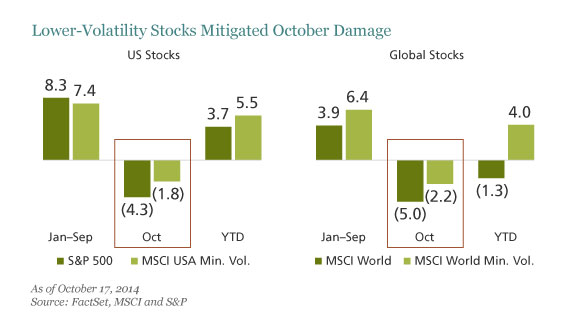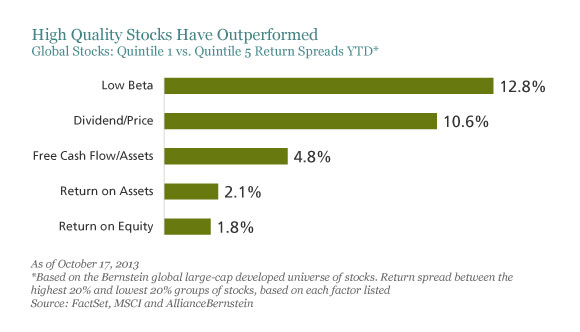After nearly nine months of calm, equity market volatility has returned and is threatening investors with the prospect of losing money. We believe the recent episode in US and global stocks reinforces the case for having a strategic allocation to equities that can withstand shocks.
Until late September, equity markets seemed complacent. Even as global economic growth signals deteriorated and geopolitical risks escalated, volatility measures fell to their lowest levels since 2006. By October 17, implied US equity market volatility, as measured by the VIX Index, had jumped to about 10% above the long-term average. But for many investors, the jolt felt even more dramatic because markets were so tranquil earlier this year.
Diminishing the Damage
When markets are placid, it’s understandably hard for investors to think about turbulence. But in fact, the only time to prepare for volatility is before it strikes. Those who did found that an allocation to stocks with less volatile characteristics absorbed much of the recent market shock, which led to better performance than being invested in the broader market over the year to date.
Return patterns are illuminating. From January through September, the S&P 500 Index returned 8.3%, outperforming the MSCI US Minimum Volatility Index—which focuses on stocks that have low absolute risk—by 0.9 percentage points (Display). The tables turned in October. This month, through October 17, less volatile stocks fell by just 1.8% while the broader market tumbled by 4.3%. As a result, in the year to date, lower-volatility stocks beat the broader market by a significant margin.

Similar performance patterns can be seen in global stocks. Here, the only difference is that the MSCI Global Minimum-Volatility Index also outperformed the broader market from January to September, because since the summer, non-US stocks had already been coping with concerns about growth—especially in Europe.
Focus on Quality Stocks
What’s been driving this performance? Looking beneath the surface, we find that stocks with less volatile characteristics (known as low beta) have done especially well this year. And stocks with higher quality characteristics (high dividends, strong cash flows and solid profitability) have also delivered strong returns (Display).

Both of these types of stocks are effective at capturing equity returns with less risk. But our analysis has shown that over a full market cycle, a strategy that combines both less volatile and quality stocks generated even stronger risk-adjusted returns than either approach alone. The reason is because they tend to work best at different times.
High quality stocks provide participation in bull markets, while low-volatility portfolios are much better at tempering losses in market slumps. So by combining both in a single portfolio, investors can maintain the higher return potential of a portfolio of stocks chosen simply for its high quality, while reducing risk more effectively than a simple, passive low-volatility screen.
Gaining More by Losing Less
This year could prove to be a case study in gaining more by losing less. Steadier stocks compound more of their gains than riskier stocks over full market cycles, in part because they don’t lose as much in sell-offs. Preserving capital in downturns can have a big impact on performance in the long run. By losing less in October, portfolios with lower volatility and quality stocks can recoup losses faster when market confidence returns.
Reacting to a downturn can be costly, especially given the natural tendency of people to sell low. Maintaining a proactive allocation to equities that are more stable in troubled markets allows investors to capture enough gains during market rallies while benefiting from protection in a downturn. This approach is designed to provide a smoother ride through market cycles. The best time to prepare for volatility is when it’s not there.
The views expressed herein do not constitute research, investment advice or trade recommendations and do not necessarily represent the views of all AllianceBernstein portfolio-management teams.